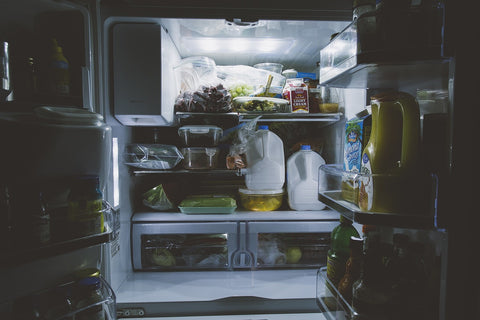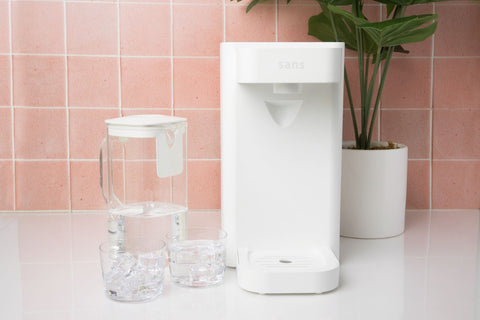Do Refrigerator Water Filters Work? (This Might Surprise You)
“My water is clean,” you think, as your refrigerator dispenses a cool glass. “Thank goodness I don’t have to worry about contaminants,” you say, as you pour another cup from that run-of-the-mill filtered pitcher on the counter.
Wait.
The filter in your refrigerator, on your faucet, or attached to your pitcher might not be putting in the effort that you think it is.
In this blog, we’re breaking down why these types of filters just don’t get the job done, plain and simple. We’ll also talk about what type of water filtration technology you should look out for and why exactly it’s so effective at what it does.
Why Don’t Refrigerator Water Filters Work Well?
There are a few specific reasons why your refrigerator water filter might not be cleaning your water as much as you think it is.

Weak Filters
First, many types of refrigerators use rather weak filters, called single-stage granular activated carbon (GAC) filters. While they can remove some contaminants, they’re smaller in size and can’t remove nearly as many pollutants in the water as other types of filters. Plus, they typically aren’t capable of removing heavy metals like lead, as well as bacteria.
And, if you live in an area where you have hard water — which happens due to calcium and magnesium — these filters won’t help. They’re simply not designed to remove particles like this, so the calcium and magnesium pass right through them.
Difficult to Clean
If we told you to take apart your refrigerator filtration system right now and clean it, would you know how to? Would you know how to get to the water line to flush it out, since contaminants can get trapped in there? Would you know how to sanitize the dispenser spout, which is likely crawling with bacteria?
Probably not, and that’s for a reason: It isn’t easy! And if you need to go through this process once or twice a year, let’s be honest — it’s probably not going to happen. It’s all too easy to let years go by without cleaning your water filtration system. In fact, some people don’t ever clean it at all.
Bacteria on the Dispenser
It’s not just the filter itself you have to worry about. Consider that your refrigerator — and specifically, the handle to open it — might be some of the dirtiest places in your kitchen. What does this mean for the filter?
Well, there are times when — whether you notice it or not — your fingers might accidentally graze the water dispenser. If you have food going bad in the refrigerator or kitchen, the dispenser can even get exposed to nasty airborne microbes.

This could mean that bad guys like fungus, yeast, bacteria, and mold are lingering on your refrigerator water filter.
What About the Filters on Faucets and Pitchers?
It’s a similar story, here. Because these filters are smaller in size, they don’t typically pack a very big punch. Is this better than nothing? Maybe, but it just doesn’t get the job done. It takes a unique kind of technology to be able to sanitize the water inside of a pitcher.
What’s the solution, then?
A New Type of Water Filtration — Effective and Cost-Efficient
When it comes to your drinking water, it’s not all doom and gloom. The technology exists — you just have to know what to look for. The magic lies in something called reverse osmosis. What does this mean?
In a nutshell, during the reverse osmosis process, water is forced through a semipermeable membrane. This membrane has microscopic pores that help to filter out the “bad guys.” In other words, these pores make it possible to separate the water molecules from other substances that you don’t want to drink.
This is why water filtration systems that utilize reverse osmosis are so much more powerful and efficient than their counterparts.

Crystal Clear Water with Sans
You now know that reverse osmosis is one of the most powerful and effective ways to clean your drinking water.
Sans uses a four-layer reverse osmosis filter to eliminate dangerous particles like arsenic, heavy metals (like lead), fluoride, chemicals, and even viruses and bacteria. These are some of the most common water contaminants.
Sans further purifies your water with UV-C light. When UV light penetrates a microorganism, it damages its cellular function so that it can’t grow any further.
The quality monitor will keep you abreast of how pure your tap water is. The water can auto-dispense into the removable pitcher, and if you’re looking to make a cup of tea, you can get hot H20 instantly.
“Well, I can just buy bottled water,” you might be thinking. But hold that thought.

If you’re aiming for the recommended eight glasses a day, you’ll be spending around $1,400 a year on bottled water. From the tap, that figure is closer to $0.49 a year. Consider, too, the environmental impact. While the average American consumes about 167 bottles of water a year, they’re only recycling about 38 of those. Plastic (especially single-use) is one of the greatest pollutants on this planet, and, ironically, it breaks down into microplastics… which end up back in our water!
Do we need any other reasons to switch to filtered water?
With the incredible capacity and speed of the Sans water purifier, you can kick contaminants to the curb and say goodbye to single-use plastic bottles. Save money, protect the earth, and safeguard your health, with one single device.
With the Sans reverse osmosis water purifier, can you feel good about the water you drink. Your body, your wallet, and the planet will all thank you for it.
Invest in your health and stay hydrated with Sans. Shop now!